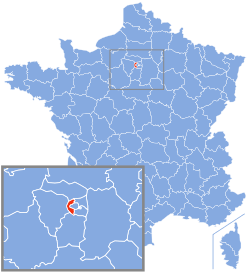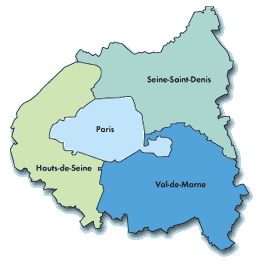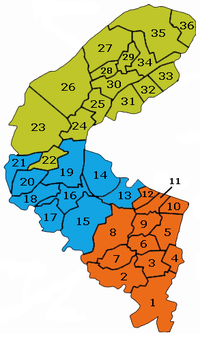Hauts-de-Seine
| Hauts-de-Seine | ||
|---|---|---|
| Department | ||
| ||
 Location of Hauts-de-Seine in France | ||
| Coordinates: 48°50′N 02°12′E / 48.833°N 2.200°ECoordinates: 48°50′N 02°12′E / 48.833°N 2.200°E | ||
| Country | France | |
| Region | Île-de-France | |
| Prefecture | Nanterre | |
| Subprefectures |
Antony Boulogne- Billancourt | |
| Government | ||
| • President of the General Council | Patrick Devedjian (UMP) | |
| Area1 | ||
| • Total | 176 km2 (68 sq mi) | |
| Population (2013) | ||
| • Total | 1,591,403 | |
| • Rank | 5th | |
| • Density | 9,000/km2 (23,000/sq mi) | |
| Time zone | CET (UTC+1) | |
| • Summer (DST) | CEST (UTC+2) | |
| Department number | 92 | |
| Arrondissements | 3 | |
| Cantons | 23 | |
| Communes | 36 | |
| ^1 French Land Register data, which exclude estuaries, and lakes, ponds, and glaciers larger than 1 km2 | ||
Hauts-de-Seine (French: [o d(ə) sɛn]; literally "Seine Heights") is a department of France. It is part of the Métropole du Grand Paris and of the Île-de-France region, and covers the western inner suburbs of Paris. It is small and densely populated and contains the modern office, theatre, and shopping complex known as La Défense.
Geography
Hauts-de-Seine and two other small départements, Seine-Saint-Denis and Val-de-Marne, form a ring around Paris, known as the Petite Couronne (i.e. "little crown") and are together with the City of Paris included in the Greater Paris since January 1, 2016.

Administration

Hauts-de-Seine is made up of three departmental arrondissements and 36 communes:
History
The department of Hauts-de-Seine was created in 1968, from parts of the former départements of Seine and Seine-et-Oise. Its creation reflected the implementation of a law passed in 1964, and Nanterre had already been selected as the prefecture for the new department early in 1965.
In the 1990s and early 2000s, the Hauts-de-Seine received national attention as the result of a corruption scandal concerning the misuse of public funds provided for the department's housing projects. Implicated were former minister and former President of the general council of the Hauts-de-Seine, Charles Pasqua, and other personalities of the RPR party. (See corruption scandals in the Paris region.)
Economy
Hauts-de-Seine is France's second wealthiest département (behind Paris) and one of Europe's richest areas. Its GDP per capita was €62,374 in 2003, according to INSEE official figures.
Politics
Hauts-de-Seine is the political base of Nicolas Sarkozy, President of the Republic from 2007 to 2012. He was previously the mayor of Neuilly-sur-Seine in the department.
Charles Pasqua was also based in Hauts-de-Seine.[1]
Demographics
Place of birth of residents
| |||||||||||||||||||
Tourism
 Empress Joséphine's bedroom at the Château de Malmaison
Empress Joséphine's bedroom at the Château de Malmaison Paris seen from the Parc de Saint-Cloud
Paris seen from the Parc de Saint-Cloud
References
External links
- (French) Website of the General council
- (French) Prefecture website
